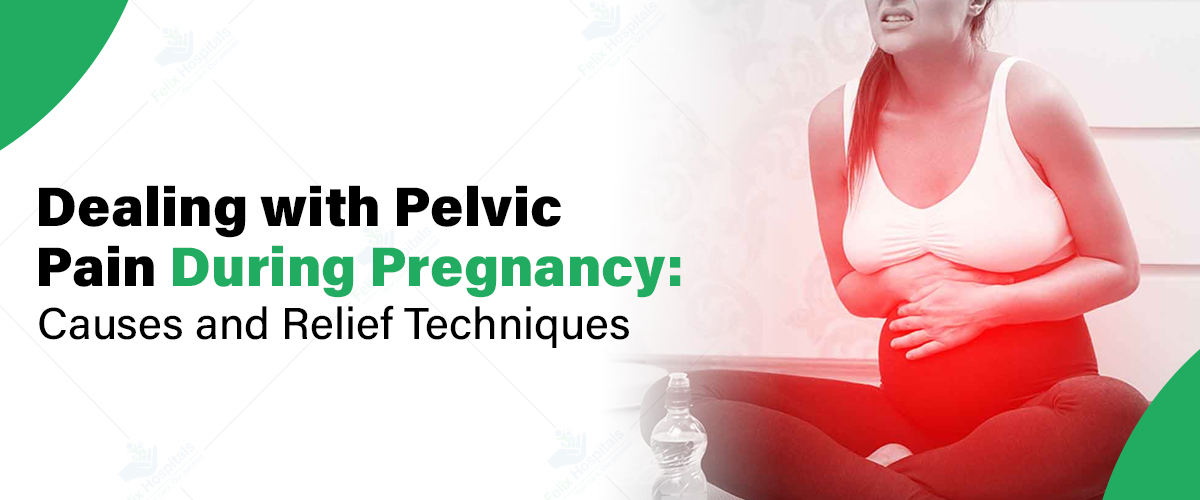
Subscribe to our

Pregnancy is a remarkable period filled with anticipation and joy, but it also brings its set of challenges. One such challenge that many expectant mothers face is pelvic pain. Understanding the causes and effective relief techniques for pelvic pain can make this journey more comfortable. In this comprehensive guide, we will explore the various aspects of and provide relief techniques.
If you're experiencing pelvic pain and are unsure about its severity or need personalized guidance, don’t hesitate. Contact us now at +91 9667064100.
Pelvic pain during pregnancy is a common experience that many women encounter. It refers to discomfort or pain in the lower abdomen, hips, and buttocks. While some degree of pelvic pain is normal as your body adjusts to the changes of pregnancy, severe or persistent pain should be evaluated by a healthcare provider. Recognizing and managing pelvic pain is essential for maintaining overall well-being and comfort during pregnancy.
During pregnancy, the body produces more of the hormone relaxin, which helps to loosen ligaments and joints to prepare for childbirth. This increased flexibility can lead to instability and pain in the pelvic region.
The additional weight gained during pregnancy adds extra stress on the pelvic joints and muscles, which can contribute to discomfort and pain.
SPD occurs when the ligaments that normally keep the pelvic bones aligned become too relaxed and stretchy. This condition can lead to pain and instability in the pelvic area.
As the uterus expands, the ligaments supporting it stretch, which can cause sharp pains or dull aches in the lower abdomen. This type of pain is often felt on one side of the pelvis.
These "practice" contractions are your body’s way of preparing for labor. They can cause discomfort in the pelvic area as the muscles tighten and then relax.
Changes in posture due to the growing belly can affect the alignment of the pelvis and lower back, leading to pain and discomfort.
During pregnancy, blood flow to the pelvic area increases, which can cause pressure and pain in the pelvis.
As the body adjusts to the growing baby, the muscles supporting the pelvis can become strained, leading to pain and discomfort.
Women with a history of pelvic or back injuries may experience aggravated pain during pregnancy due to the added strain on the pelvic area.
Engage in prenatal yoga or swimming to strengthen the pelvic floor muscles and improve flexibility. Specific exercises like pelvic tilts and Kegel exercises can also help alleviate pain.
Maternity support belts or pelvic support garments can help stabilize the pelvic area and reduce discomfort. These garments are designed to support the growing belly and relieve pressure on the pelvis.
Avoid standing for long periods and use proper lifting techniques by bending at the knees instead of the waist. Sleep on your side with a pillow between your knees to maintain better alignment and reduce pain.
Applying a warm compress to sore areas can provide relief. Alternatively, some women find that cold packs help reduce inflammation and pain.
Prenatal massage can help relax tense muscles and improve circulation. Acupuncture has also shown promise in relieving pregnancy-related pelvic pain.
Always consult with your healthcare provider at the best gynecology hospital in Noida before taking any medication during pregnancy. They may recommend safe pain relief options if necessary.
Take frequent breaks throughout the day and practice relaxation techniques like deep breathing or meditation to manage stress and reduce pain.
Soaking in a warm bath can help ease pelvic pain and relax tense muscles. Ensure the water temperature is comfortable and not too hot.
Regular checkups with a gynecologist or physical therapist who specializes in pelvic pain can provide personalized advice and treatment options.
For personalized care and relief from pelvic pain during pregnancy, schedule an appointment by Clicking Here.
Pelvic pain during pregnancy can be a challenging experience, but understanding its causes and employing effective relief techniques can significantly improve your comfort and well-being. It's important to listen to your body and work closely with your healthcare provider to manage pain effectively. Remember, while pelvic pain can be distressing, it is often manageable with the right strategies and support. Stay patient, and take proactive steps to address your discomfort, knowing that your healthcare provider is there to support you throughout this special journey.
1. Is pelvic pain a common issue during pregnancy?
Yes, some degree of pelvic pain is common during pregnancy, but severe or persistent pain should be evaluated by a healthcare provider.
2. Can exercise help with pelvic pain?
Gentle exercises and prenatal yoga can strengthen pelvic floor muscles and improve flexibility, which may help alleviate pain.
3. When should I seek medical help for pelvic pain?
Consult your healthcare provider if the pain is severe, persistent, or accompanied by other concerning symptoms.
4. Are there any medications safe for relieving pelvic pain during pregnancy?
Always consult your healthcare provider before taking any medication. They can recommend safe options if necessary.
5. How can I manage pelvic pain while sleeping?
Sleeping on your side with a pillow between your knees can help maintain proper alignment and reduce discomfort.
6. Can dietary changes affect pelvic pain?
While diet alone may not directly impact pelvic pain, maintaining a balanced pregnancy diet supports overall health and may contribute to overall comfort.
7. What is Symphysis Pubis Dysfunction (SPD)?
SPD is a condition where the ligaments that keep the pelvic bones aligned become too relaxed, leading to pain and instability.
8. How long does pelvic pain typically last during pregnancy?
The duration of pelvic pain can vary for each individual and may persist throughout pregnancy. Consult your provider for personalized advice.
9. Can complementary therapies like acupuncture help with pelvic pain?
Some women find relief from pelvic pain through complementary therapies such as acupuncture. Consult with your healthcare provider to explore these options.